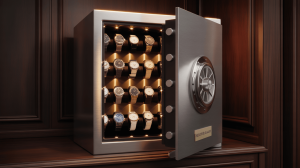Gifting or upgrading your home security often means choosing between protecting valuables and maintaining watch accuracy. Imagine a single unit that does both. A home safe with a built-in watch winder stores jewelry, important documents, and other valuables. At the same time, it keeps automatic watches wound and ready to wear. This innovative solution saves space, time, and effort. Every morning becomes seamless. No more dead watches or scattered jewelry.
1. Understanding the Dual-Function Concept
A home safe with a watch winder offers two primary features. First, it locks away valuables behind thick steel walls. Second, it has rotating modules to keep automatic watches moving. Instead of a separate safe and winder, you get one cohesive unit. This integration streamlines security and daily routines. It prevents you from juggling multiple devices and reduces clutter.
2. Security Features Explained
Security is at the core of any home safe. These units often use 12–14 gauge steel walls. Their doors have multi-point locking bolts. Many models meet UL RSC burglary standards. This certification ensures resistance against pry bars, drills, and impact tools. Fireboard insulation and intumescent gaskets meet UL 72 Class 350 fire ratings. They protect contents from heat up to 1,200°F for 30 minutes. Some models add biometric or electronic locks for personalized access. You can bolt the safe down to floor joists or wall studs for extra stability.
3. Watch Winding Precision
Automatic watches need movement to maintain accuracy. Built-in winder trays simulate wrist motion. You can program turns-per-day (TPD) from 650 to 2,000. Directional controls allow clockwise, counterclockwise, or bi-directional rotation. Pause intervals prevent over-winding. High-quality Japanese or Swiss motors run under 25 dB. Rubber-damped mounts reduce vibration. Over time, this level of care extends a watch’s service intervals and preserves its movement integrity.
| Feature | Specification | Benefit |
|---|---|---|
| TPD Range | 650–2,000 turns/day | Maintains accurate timekeeping |
| Direction Options | CW, CCW, Bi-directional | Protects winding mechanisms |
| Noise Level | < 25 dB | Whisper-quiet operation |
4. Organizing Jewelry and Valuables
Inside the safe, padded drawers keep jewelry organized. Ring rolls hold bands upright and prevent scratches. Earring posts keep pairs together. Necklace hooks suspend chains to avoid tangling. Some models include hidden compartments for documents, passports, or spare watch straps. Velvet or suede linings protect precious metals and gemstones. This thoughtful layout ensures each item has its own place. You never have to dig through piles to find a piece.
5. Climate and Humidity Control
Humidity can damage leather watch straps and tarnish metals. Many safes include passive desiccant chambers. Some add active dehumidifiers for precise humidity regulation. IP54-rated door seals prevent dust and moisture from entering. Digital hygrometers display real-time humidity levels. Maintaining 40–50% relative humidity protects pearls, silver, and leather. This environment reduces the need for frequent cleaning or repairs.
6. Aesthetic Appeal and Display Lighting
A home safe with a watch winder doubles as a luxury decor piece. Exterior finishes include matte-black steel, walnut veneer, and leather wraps. Built-in LED strips highlight watches and jewelry without generating heat. Fiber-optic spotlights focus on key items. Motion sensors activate lights when the door opens. The safe thus transforms into a gallery, showcasing prized items elegantly.
| Lighting Type | Placement | Effect |
|---|---|---|
| LED Strip Rails | Under top trim | Even illumination |
| Fiber-Optic Spots | Above compartments | Focused accent lighting |
| Motion Sensors | Door frame | Automatic on/off convenience |
7. Smart Connectivity Features
Advanced models include Bluetooth or Wi-Fi modules. They send tamper alerts, door-open notifications, and low-battery warnings to your smartphone. An app lets you lock and unlock remotely. You can adjust winding schedules and view access logs. Enterprise-grade encryption protects these connections. With real-time monitoring, you stay in control even when traveling.
8. Power and Backup Access
Dual-power systems ensure continuous operation. An AC adapter powers the safe daily. A rechargeable lithium-ion battery pack serves as backup. Low-battery LED indicators or app notifications warn you before shutdown. A hidden mechanical override key or combination dial provides manual access if electronics fail. You never risk being locked out or leaving watches unwound.
9. Installation and Anchoring Best Practices
Proper installation is vital for security and stability. First, locate floor joists or wall studs using a stud finder. Use heavy-duty lag or sleeve anchors rated for the safe’s total weight. Level the unit before tightening anchors to prevent door binding. Conceal anchor heads beneath interior liners for a clean appearance. Professional installation is recommended for larger models.
| Step | Action | Tip |
|---|---|---|
| Locate Studs/Joists | Use a stud finder | Mark points before drilling |
| Choose Anchors | Heavy-duty lag/sleeve anchors | Match anchor strength to weight |
| Level Safe | Adjust base before tightening bolts | Prevent door binding |
10. Silent, Vibration-Free Operation
Quality winding motors sit on rubber-damped mounts. Precision bearings keep noise levels under 25 dB—barely a whisper. Soft-close hinges eliminate slamming. Locking bolts operate silently. This ensures the safe works discreetly, even in a bedroom or study. You won’t hear humming or clicking during the winding cycles.
11. Maintenance and Care Guidelines
Routine care preserves both the safe and contents. Dust exterior surfaces weekly with a microfiber cloth. Run empty winding cycles monthly to keep motors healthy. Test locks and electronics quarterly. Replace desiccant packs every 6–12 months. Swap backup batteries annually. Lubricate mechanical locks per the manufacturer’s instructions. Keep a service log to track maintenance dates and performance notes.
12. Cost vs. Value Analysis
Hybrid safes range from $1,500 to over $10,000. Entry-level models start at $1,500 for 2–4 winding bays and basic jewelry drawers. Mid-range options ($2,500–$5,000) add climate control, LED lighting, and app-based alerts. Premium units ($5,000+) feature custom veneers, biometric locks, and full IoT integration. Many insurance companies offer discounts for certified burglary and fire protection. Over time, reduced watch service fees and fewer jewelry repairs offset initial costs.
| Tier | Price Range | Key Features |
|---|---|---|
| Entry-Level | $1,500–$2,500 | 2–4 winders, basic jewelry drawers |
| Mid-Range | $2,500–$5,000 | Climate control, LED lighting, app |
| Premium | $5,000+ | Custom finishes, biometric lock |
13. Space Considerations and Custom Fit
Safes come in various sizes. Compact countertop units hold 2–4 watches and a modest jewelry collection. Floor models accommodate 10+ watches and extensive jewelry. Measure door swings and drawer clearances before purchase. Ensure easy access to power outlets. For built-in installations, recess the unit into a closet or wall cavity. Custom cabinetry integration creates a seamless look that complements your decor.
14. Alternatives to a Hybrid Safe
If a combined unit seems excessive, consider separate solutions. A standalone watch winder costs $200–$500 for a 2-bay unit. A dedicated jewelry safe runs $300–$800 for moderate capacity. While cheaper, separate devices require more space and management. You juggle two keys or codes and risk mismatched security certifications. Hybrid safes offer unified protection and convenience under one roof.
15. Who Benefits Most from This Solution?
Collectors with both automatic watches and valuable jewelry benefit greatly. Frequent travelers appreciate remote alerts and battery backups. Homeowners seeking maximum security love the certified burglary and fire ratings. Casual wearers might find standalone options sufficient. Evaluate your collection’s size, lifestyle, and budget before choosing. For those who value convenience and security equally, a hybrid safe with a watch winder is the perfect choice.
| Collector Profile | Recommendation | Reasoning |
|---|---|---|
| Watch Enthusiast | Hybrid safe with multiple winder bays | Keeps watches accurate and secure |
| Jewelry Aficionado | Hybrid safe with deep jewelry drawers | Organizes and protects jewelry |
| Occasional User | Standalone winder + jewelry safe | Budget-friendly, space-saving |
FAQ
Q1: Can I store both quartz and automatic watches?
Yes. Quartz watches sit in static trays, while automatics use winding modules.
Q2: How often should I replace desiccant packs?
Replace every 6–12 months based on local humidity to maintain ideal relative humidity.
Q3: Are smart alerts secure from hacking?
Premium models use AES encryption and require strong, unique passwords for remote access.
Q4: Do these safes require professional installation?
Recommended for heavy or built-in models to ensure proper anchoring and stability.
Q5: Can I expand capacity later?
Yes. Modular trays and drawer kits allow you to add extra winding bays or jewelry sections over time.







